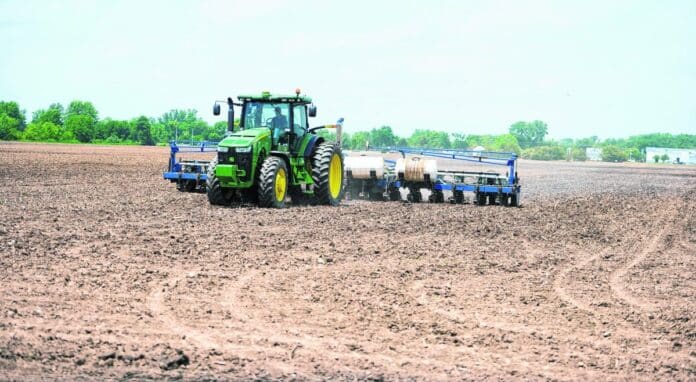
HANCOCK COUNTY — The planter Charles Jacobi hauled behind his tractor kicked up clouds of dust over the farm field just outside McCordsville.
It was a rare sight for a spring that’s been riddled with rain.
Before yet another downpour on Wednesday afternoon, farmers in Hancock County were hustling through the recent relatively dry weather to get seeds into the soil.
[sc:text-divider text-divider-title=”Story continues below gallery” ]
Click here to purchase photos from this galleryPlanting season is coming down to the wire. While there’s still plenty of mud in the fields continuing to delay their work, farmers still have options, such as faster-growing seeds, insurance and federal aid along with one other component Jacobi says every farmer needs — optimism.
Work has been able to ramp up as of late, but area farmers are still far behind where they’d typically be. Jacobi said on Wednesday afternoon that by the time he finished planting that day, he’d have only about 30 percent of his corn in the ground.
The Indianapolis area saw no rain from May 31 to June 4, according to the National Weather Service. But the conditions still haven’t allowed Jacobi to plant any of his soybeans.
“The bean ground has just been too wet to get into,” he said.
It got a lot wetter just a few hours later, when the skies darkened and a fast-moving storm dumped more than half an inch of rain in the area.
Robert Nielsen, an agronomy professor at Purdue University, said in a webinar late last month that corn farmers are now in a period where the longer they wait, the less they can expect at harvest time.
“After about the middle of May, corn yields decline approximately one to two bushels per acre per day,” Nielsen said.
To improve his crops’ chances, Jacobi traded the seed he started out with for a shorter-season hybrid. The plants will mature about a week faster than what he typically plants. Under the right conditions, that maturity should be complete by around Sept. 20, he said.
Nielsen emphasized during the webinar that growing conditions also have a significant impact on how yields turn out.
Jacobi compared this spring to 1981, when rain kept him from planting until June 7. But optimal growing conditions helped farmers weather that storm, and they lucked out with a late fall, he said.
“We had a real hot September and October,” he said. “Didn’t frost until up in November, and it turned out to be a decent year. Nothing to brag about, but it was a decent year.”
Jacobi just hopes he doesn’t see another year like 1967, when crops were not only delayed by a late spring but were also rocked by an early frost in September.
“It was a disaster,” he said.
He finds solace in the fact that he has no control over the conditions.
“It’s all up to God upstairs,” he said.
That notion is important to understand, Jacobi continued.
“You have to,” he said. “I can’t imagine being a farmer and not having faith.”
This week, it was too early for Jacobi to tell whether he’d be unable to plant on any of the remaining land he farms and instead seek insurance.
He remains hopeful — a trait he added every farmer has.
“We don’t have a choice,” he said. “We’re the most optimistic people in the world or we wouldn’t be doing it.”
The final planting date for full insurance coverage on corn crops was June 5. Farmers can continue planting through June 25, but coverage reduces each day. The final date for soybeans is June 20. Planting can continue through July 15, but, like corn, with daily reduced coverage.
Then there’s the farming aid package that the U.S. Department of Agriculture announced last month. While full details have not been released, aid will be based on a county rate multiplied by a farm’s total plantings in 2019.
If insurance does weigh in to Jacobi’s decisions, he’ll have to determine whether the benefit would be greater than the planting-based aid.
He’s grateful the assistance is available, not only for himself, but all farmers.
“If it wasn’t for that aid, we’d be in trouble,” he said.
Roy Ballard, Purdue Extension Hancock County educator for agriculture and natural resources, said every farmer in the county is making the same calculations as they fire up their equipment.
“It’s going at a fevered pace right now,” he said.
As farmers hurry to make up for lost time, Ballard urges them not to rush to the point it becomes dangerous.
“It’s crunch time, and I just really, really hope people don’t sacrifice safety for that last corn in the ground,” he said. “There are a lot of corners that can be cut, and some of those could last a lifetime. I want to encourage people to be safe and really keep that in the front of their minds as they finish their chores.”




